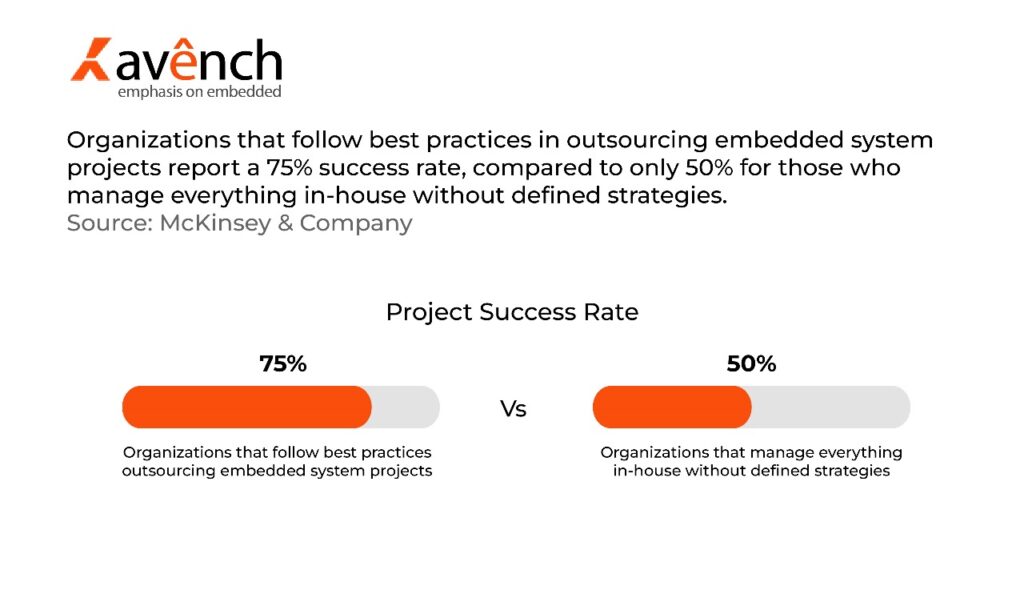The choice between in-house development and embedded system for outsourcing(os) is a critical decision for organizations looking to optimize their technology capabilities. Each option presents unique challenges, particularly when it comes to managing complex, real-time embedded systems. Understanding the common pitfalls associated with each approach can guide companies in making informed decisions. This blog outlines the top five pitfalls to avoid, providing insights into best practices for both in-house and outsourced embedded systems projects.

Pitfall 1: Insufficient Requirements
The Role of best outsourcing for embedded systems
A comprehensive requirements definition is essential in embedded system outsourcing (OS). Failing to clearly define project needs can lead to misunderstandings, scope creep, and wasted resources.
Best Practices for Requirements Gathering
- Engage Stakeholders: Involve all relevant stakeholders, including engineers, project managers, and end-users, in the requirements-gathering process. This ensures that every perspective is considered and that the final requirements are well-rounded and complete.
- Document Thoroughly: Create detailed documentation that outlines both functional and non-functional requirements. This should include performance metrics, user expectations, and integration points. Clear documentation serves as a reference point throughout the project lifecycle.
By emphasizing the importance of clear requirements, organizations can lay a solid foundation for project success, whether in-house or outsourced.
Pitfall 2: Ineffective Communication
Importance of Communication
Effective communication is vital for any project, but it becomes increasingly critical when teams are dispersed across different locations, particularly in outsourced projects. Miscommunication can lead to missed deadlines and subpar quality.
Strategies for Improving Communication
- Utilize Collaborative Tools: Implement project management and communication tools that facilitate real-time updates and discussions. Tools like Slack, Trello, or Jira can help keep everyone on the same page.
- Regular Check-ins: Schedule regular status meetings to discuss project progress and address any concerns. This helps to create a rhythm of accountability and keeps the project aligned with its goals.
Prioritizing effective communication can significantly reduce misunderstandings and enhance collaboration among teams, ultimately leading to better project outcomes.
Pitfall 3: Overlooking Cultural Differences
Cultural Challenges in customizing Outsourcing for embedded systems
When outsourcing embedded systems, cultural differences can present challenges. These differences can affect communication styles, work ethics, and expectations, leading to potential friction.
How to Navigate Cultural Differences
- Cultural Awareness Training: Provide training for both in-house and outsourced teams to foster understanding of cultural nuances. This can improve interpersonal interactions and promote a collaborative atmosphere.
- Build Relationships: Encourage informal interactions between teams to build rapport. This can create a more cohesive working environment and improve overall teamwork.
Addressing cultural differences proactively can enhance collaboration and create a more harmonious working relationship between in-house and outsourced teams.
APitfall 4: Underestimating Real-Time System Complexity
Complexity in Real-Time Systems
Real-time embedded systems require precise timing and high reliability. Underestimating the complexity of these systems can result in significant challenges, including performance issues and project delays.
Managing Complexity Effectively
- Select Experienced Partners: When outsourcing, choose vendors with a proven track record in developing real-time embedded systems. Evaluate their previous projects and ask for case studies that demonstrate their expertise.
- Implement Rigorous Testing Protocols: Establish thorough testing procedures from the outset. Frequent testing throughout the development process ensures that performance metrics are met and that potential issues are identified early.
By recognizing and addressing the complexities associated with real-time embedded systems, organizations can mitigate risks and improve project outcomes.

Pitfall 5: Not Customizing Outsourcing for Embedded Systems
Importance of Customization
Many organizations overlook the necessity of customizing outsourcing arrangements to meet the specific requirements of embedded systems projects. A lack of alignment between outsourcing partners’ capabilities and project needs can lead to suboptimal results.
Strategies for Successful Customization
- Define Specific Needs: Clearly outline project requirements and expectations when selecting a vendor. This should include details about the embedded system’s functionality, performance criteria, and integration needs.
- Engage in Collaborative Planning: Work closely with potential outsourcing partners during the planning phase. Discuss how their services can be customized to align with your project’s objectives, focusing on the best outsourcing options for embedded systems.
Customizing the outsourcing process to fit the unique demands of embedded systems can significantly enhance the likelihood of project success.
Summary of Key Points
- Requirements Definition: Involve stakeholders and document requirements thoroughly.
- Communication: Use collaborative tools and hold regular check-ins.
- Cultural Awareness: Provide training and encourage relationship-building.
- Complexity Management: Choose experienced partners and implement rigorous testing.
- Customization: Define specific needs and engage in collaborative planning.
Navigating the complexities of embedded systems—whether through outsourcing or in-house development—requires a strategic approach. By focusing on these common pitfalls and implementing proactive measures, organizations can improve decision-making processes and increase the likelihood of successful project outcomes. Understanding these critical areas will help ensure that embedded system projects are executed effectively, aligning with both organizational goals and user needs.
Avench systems are the best outsourcing(os) for embedded systems, to know more information for any sales queries, wait for no further contact us at +1 (775) 404-5757. You can also email us at sales@avench.com, or fill the query form in a website.
Avench is one of the leading embedded companies in bangalore, to know more information for any sales queries, wait for no further contact us at +1 (775) 404-5757. You can also email us at sales@avench.com, or fill the query form in a website.

